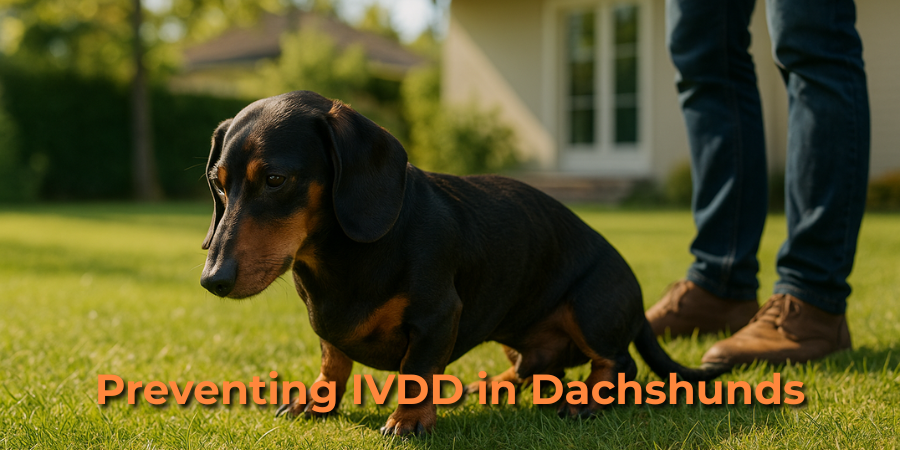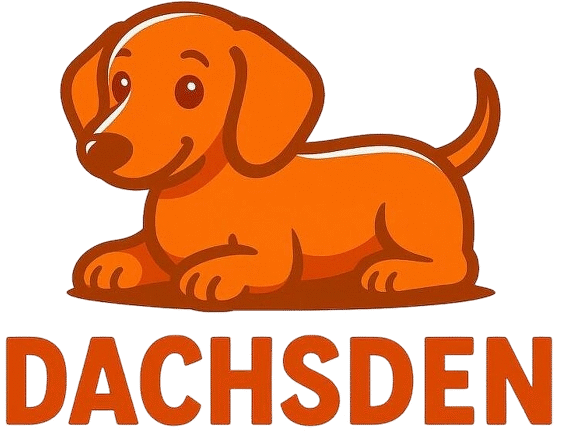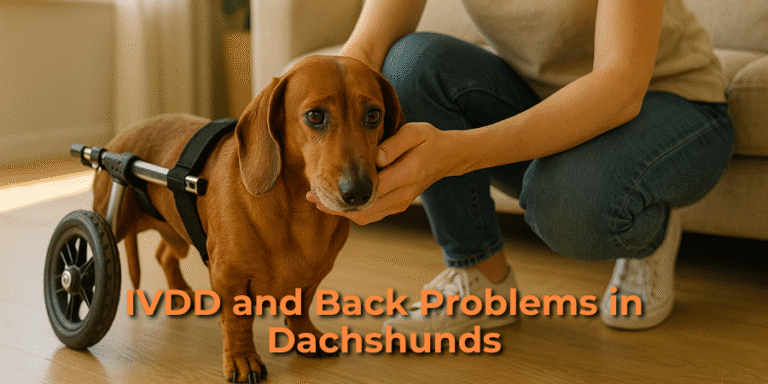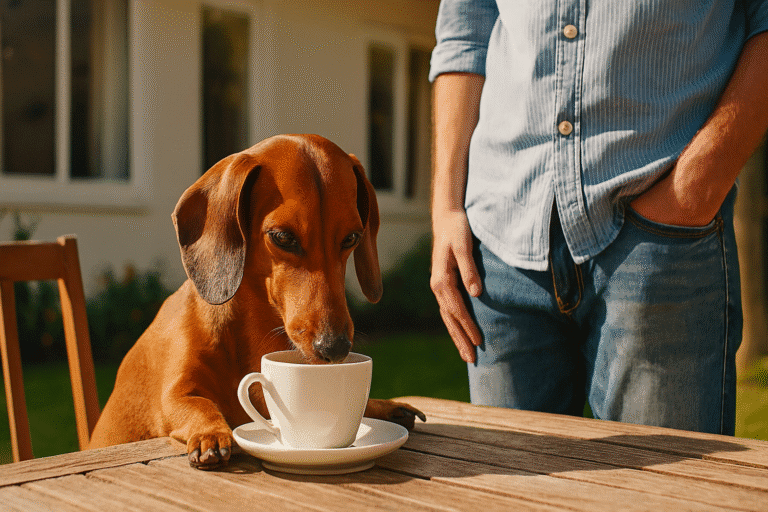Preventing IVDD in Dachshunds
If you’re currently going through Dachshund IVDD or want to prevent it, simple habits can truly help your Dachshund. These smaller dog breeds with a short stature and extra-long spine are very susceptible to this debilitating disease.
From personal experience, using ramps, avoiding furniture jumps, managing weight, and supporting their back when lifting are essential steps. Let’s learn these easy ways to keep our pups safe and pain-free.

Preventing IVDD in Dachshunds – Short Answer
To prevent IVDD in your Dachshund, maintain a healthy weight through a balanced diet and regular low-impact exercise like controlled walks or swimming to reduce spinal stress.
What is IVDD in Dachshunds?
IVDD (Intervertebral disc disease) is a serious condition that affects around 25% of dachshunds. Their long spine and short legs make them more susceptible than other breeds.
Over time, the intervertebral discs circular pads of cushioning between each vertebra can deteriorate, calcify, harden, and start bulging or bursting, often triggered by jumping, rough play, or other physical activity.
These discs are important to the normal function of the spine, helping to protect the nerves in the middle. Preventing IVDD means avoiding high-impact actions like jumping off the couch and keeping movement gentle. For an in-depth breakdown of the condition, consult detailed resources available on this topic.
Causes & Risk Factors
Genetic Predisposition
As a long-time dachshund owner, I’ve learned that IVDD isn’t just about movement or weight it has a deep genetic link. The short-legged structure of dachshunds is a major causal factor in this disease.
Disc Calcification
Their discs in the spine begin to calcify at a much younger age compared to normal-legged breeds, making them more vulnerable over time. This short-legs trait is heritable, meaning it runs in families, so even healthy-looking dogs may carry the risk.
I’ve also seen that being fit, in good body condition, and active doesn’t always mean your dog will avoid back problems.
Lifestyle & Environment
From my experience with dachshunds, IVDD is a disease that’s often caused by multiple genes, not just one single issue. But it doesn’t stop there, environmental and lifestyle factors also play a big part. Even with great care, these hidden risks can still affect your dog’s spine health.
Signs & Symptoms of IVDD
Early Symptoms
- Reluctant to move or do daily activities
- Unusually quiet or withdrawn
- Trembling, shaking, or crying/yelping
- Shows sensitivity to touch
- Avoids full body shake or rolling over
- Hunched back
- Limping or walking unusually
- Head held high or low with a stiff neck
- Spasms in the neck muscles
Advanced Symptoms
- Severe pain
- Drunk walking
- Cannot stand or wag tail
- Loss of bowel control and cannot urinate
- No interest in food
- No deep pain sensation
Preventing IVDD in Dachshunds
Maintain Healthy Weight
A complete, well-balanced diet is important to keep dachshunds in ideal body condition and provide key nutrients. Each dog is different based on life stage puppy, adult, or senior and lifestyle highly active or not very active.
Obesity is a common health issue and an increased risk factor for IVDD. Regularly monitor weight by feeling for the ribs, spine, and pelvic bones under the coat and soft tissue. If your pup seems chonky, cut back on snacks and use measuring cups or digital kitchen scales to control food intake—especially when managing more widespread wellness concerns.
Exercise Moderation
Ideally, every dachshund should avoid high-impact activities that put excessive force on the spine, like jumping, high-speed running, or any activity that stresses the back. Even common movements done every day can be risky.
These include jumping on or off the bed, couch, or car, going up/down stairs, and running fast to chase a dog, ball, or car. Also, discourage rough-housing with other pets or humans, as these actions can easily strain the spine.
Use Ramps and Harnesses
Walking your dachshund keeps them fit and healthy, but it’s important to avoid pulling, jerking, or walking too far ahead on the lead, as it strains the spine. Use a harness to control walks and support proper training—especially helpful if you’ve noticed strange posture habits during walks.
At home, use ramps with a gentle incline they’re recommended to stop jumping on or off furniture or using stairs. These can be bought, constructed, and strategically placed to prevent back injury.
Lift Safely
Always ensure that anyone lifting a dachshund knows how to safely support their back.
To avoid back injury, always pick up and carry them correctly with one hand under the chest and the other hand under the rump. Keep the body level at all times to prevent excessive twisting of the back.
Crate Training
Crating at night and confining your dachshund to a pen during the day when not at home can prevent high-risk activities. Crates make cozy doggy dens and offer a safe, comfortable sleeping environment.
Crate training your dachshund will ensure they’re used to the crate for future circumstances that may need prolonged confinement and rest, such as during recovery from injury.
Diet and Supplements
Life-Stage-Appropriate Food
Studies found no difference in IVDD rates among various diets whether complete, wet, raw, or combinations. Similarly, IVDD risk didn’t change between dogs receiving supplements like glucosamine and chondroitin and those who did not.
Interestingly, dogs given cod liver oil showed half the rate of IVDD, suggesting it may offer some preventive benefits. That said, always keep an eye out for food sensitivities that may complicate nutritional plans.
Supplements for Joint Support
Supplements are widely available to assist dogs with their overall health, especially with joint supporting properties.
Options like 4Cyte, Antinol, Omega 3 Oils, and prescription diets such as Hills Mobility can be helpful additions to a preventive care plan for IVDD.
Vet Checkups and Monitoring
Annual Exams
Regular check-ups with a veterinarian and a proactive approach to health care can ensure your dachshund lives a long, healthy life—and helps catch signs of IVDD before they become serious. Sometimes, early warning signs aren’t directly spinal but still linked to overall health.
Know the Symptoms
You can catch IVDD early by recognizing pain signs or coordination issues. Quick action can make a major difference in your dachshund’s recovery and long-term health.
Financial Planning for IVDD
Pet Insurance
Pet insurance and finance are vital in managing the care of dachshunds, especially if your dog becomes hospitalised or is rushed to the nearest speciality clinic for urgent surgery.
With statistics showing 1 in 4 dachshunds will face a disc episode in their lifetime, and with expenses from spinal surgery and alternative therapies being incredibly costly, it’s essential to plan ahead and explore these options early when facing the challenges of IVDD.
Emergency Fund
Having savings or emergency funds set aside specifically for your dachshund’s healthcare can create a financial safety net. This helps you handle unexpected expenses without stress when urgent care is needed.
Treatment Options for IVDD
Conservative Management
Conservative care involves treatment with steroids and anti-inflammatory drugs to reduce swelling, pain, and protect the spinal cord. The dog must stay confined in a crate or cage, with strict crate rest for 6–8 weeks.
If there’s sensation in the hind legs, many dogs can regain the ability to walk with surgery and rehabilitative care.
Though not a cure for all, this method helps manage the spinal problem through rest, crate confinement, and reducing activities to support recovery and build strength.
Surgery
If damage is severe and the dog is paralyzed or incontinent, conservative treatment may be not enough. Emergency surgery like a laminectomy, which removes part of the bony vertebrae over the spinal cord, may be needed.
The sooner the operation, the better chances to walk again. A trained neurologist is recommended over a general veterinarian. Even if successful, other discs may still rupture in the future with IVDD.
Daily Lifestyle Tips for Dachshund Owners
Combine On- and Off-Lead Walks
Highly or moderately active dogs over the age of 3 had half the rate of IVDD incidents compared to mildly or not at all active dogs. Those exercised only with free running or playing in the garden were 1.8 times more likely to suffer from IVDD than dogs also taken for walks on/off the lead.
Don’t Overprotect
While prevention is always better than cure, making smart lifestyle choices can help reduce the risk of your dog developing a back problem.
Still, it’s important to let your dachshund enjoy life over-protecting them or wrapping them in “cotton wool” to avoid injury can lead to no fun for either of you.
Track Behavior & Breathing
Panting and fatigue after little effort may indicate discomfort or spine pressure early signs that shouldn’t be ignored when monitoring your dachshund’s health.
Additional Value-Add Insights
Consider Genetic Testing
Some companies now offer genetic screening to identify dogs at high risk of IVDD, providing an early tool for prevention and planning.
Introduce Hydrotherapy
Low-impact exercise such as underwater treadmill therapy can improve mobility in IVDD-prone dogs, supporting joint health and reducing strain on the spine.
Enrichment Without Impact
Use toys, puzzles, and nose work games to stimulate your dog’s mind without stressing the spine, offering safe and engaging activities for IVDD prevention.
Conclusion
Preventing IVDD in Dachshunds comes down to smart daily choices maintaining a healthy weight, avoiding high-impact activities, encouraging safe movement, and staying alert to early signs.
With the right care, awareness, and proactive habits, you can give your dachshund the best chance at a long, active, and pain-free life.
FAQ’s
How to avoid Dachshund getting IVDD?
Keep your dog in good physical condition with exercise, a correct weight, a harness instead of a collar, and avoid jumping to prevent back problems.
What age do Dachshunds get IVDD?
Dachshunds are most likely to develop Intervertebral Disc Disease (IVDD) between ages 3 and 7, though it can occur at any age in predisposed breeds.
What are the odds of a Dachshund getting IVDD?
Dachshunds are at a significantly higher risk of IVDD, with 19–24% likely to develop it during their lifetime compared to other breeds.
Can you prevent back problems in Dachshunds?
To prevent back problems, dachshunds need a healthy weight, ramps instead of jumping, and regular exercise to strengthen core muscles.







